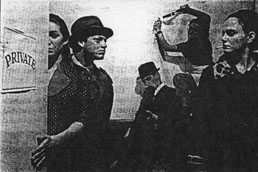
Dada’s Home
by Brian Parks
The voice cackles a blast of very odd theology: “Does God like to be all grapes and bloody?”
A ’40s detective in trench coat and fedora carries his office door on his back. A tall, suspicious man shuffles forward speaking through a long black tube. Physics lectures and Muzak, the femme fatale, a menacing weather announcer — and that strange taped voice of obscure Canadian novelist W.O. Mitchell.
It’s E.R.S.’s Spine Check.
Part Robert Wilson, part Buster Keaton, with logics both Jung and cable TV, E.R.S. is a Downtown theater group whose work can best be described as a kind of intuitive art-slapstick. They are young actors whose collective head swims gleefully in the pop-cult ether. Their first show, 1991’s Mr. Antipyrene, Fire Extinguisher, was Tristan Tzara’s play exploded into the Post-It-strewn world of the office temp. It was followed last year with Marx Brothers on Horseback Salad, the freely reimagined story of Salvador Dalí’s lost screenplay for the Marx Brothers: dismembered arms and “Ode to Billy Joe” figured prominently. If any E.R.S. piece can be said to have a plot, Spine Check is about a detective, a woman, and mysterious weather — “a forecast noir,” actor James Hannaham calls it.
“I want to do theater that’s about those bizarre, unexplainable moments that happen in between what you understand in a story.” says E.R.S. director John Collins. “All the strange things that happen between the important parts.”
E.R.S., or Elevator Repair Service — the result of a vocational-interest survey the 23-year-old Collins once took — do not work from a script. Using a found text, like a physics book or the rumor of Dalí’s screenplay or the clichès of a form, they develop a project in rehearsal, taking the text apart, leaving only its skeleton as a play’s structure. Then the weird shit starts.
Trash-picking the culture, they’ll find a language tape or a curious noise on a sound-effects record, then shape a scene or character around it. “It’s like working backward,” Collins says. “It’s a way of letting things determine themselves.” An E.R.S. show evolves by mixing and arranging the moments the group has created through their often raucous experiments. “When I was an actor,” Collins notes, “what I enjoyed most were all the strange things that happened during rehearsal that got tossed out because they didn’t make sense. I think those things do make sense, have their own logic. Because they’re real.”
E.R.S. are masterful sound designers, and in certain ways a show is an animation of its surreal, jumpy soundtrack, which typically flips back and forth between music samples, peculiar voices, and dislocated noises. Their constructions are also extremely visual, with film a big influence. “We approach movies as if we were really boring Finnish accountants,” says actress Colleen Werthmann. “And what strikes us is what’s most bizarre or fanciful or upsetting or weird.”
Collins and crew — which in addition to Werthmann and Hannaham includes Bradley Glenn, Susie Sokol, Marinda Groff, Leo Marks, Steve Bodow, and Blake Koh — are about crashing things together and rebuilding from the pieces, about using theater to get at those tweaks of sensibility that come from scattered logic. It’s the fine art of screwing around. Their work is inherently a critique, a challenge to visual-aural-narrative assumptions. But all done with a smile — sort of. “I always want things to be funny,” Collins says. “But funny in a very particular way. Not comedy with a capital C — but getting to that invisible, undefinable thing that is not about making people laugh.”
Appropriation, collage, and a dada slide of radical juxtaposition. Postmodernism, anyone? Well, yeah. There’s life in ol’ Betsy yet.